Artist Collection: Feeder on vintage Jazzmasters, Gibsons and more
For a quarter of a century, Feeder have endured as one of the UK’s most consistent rock bands, outlasting many of their peers and still going strong. We sit down with frontman Grant Nicholas and bassist Taka Hirose to talk through the instruments that have shaped their musical journey.
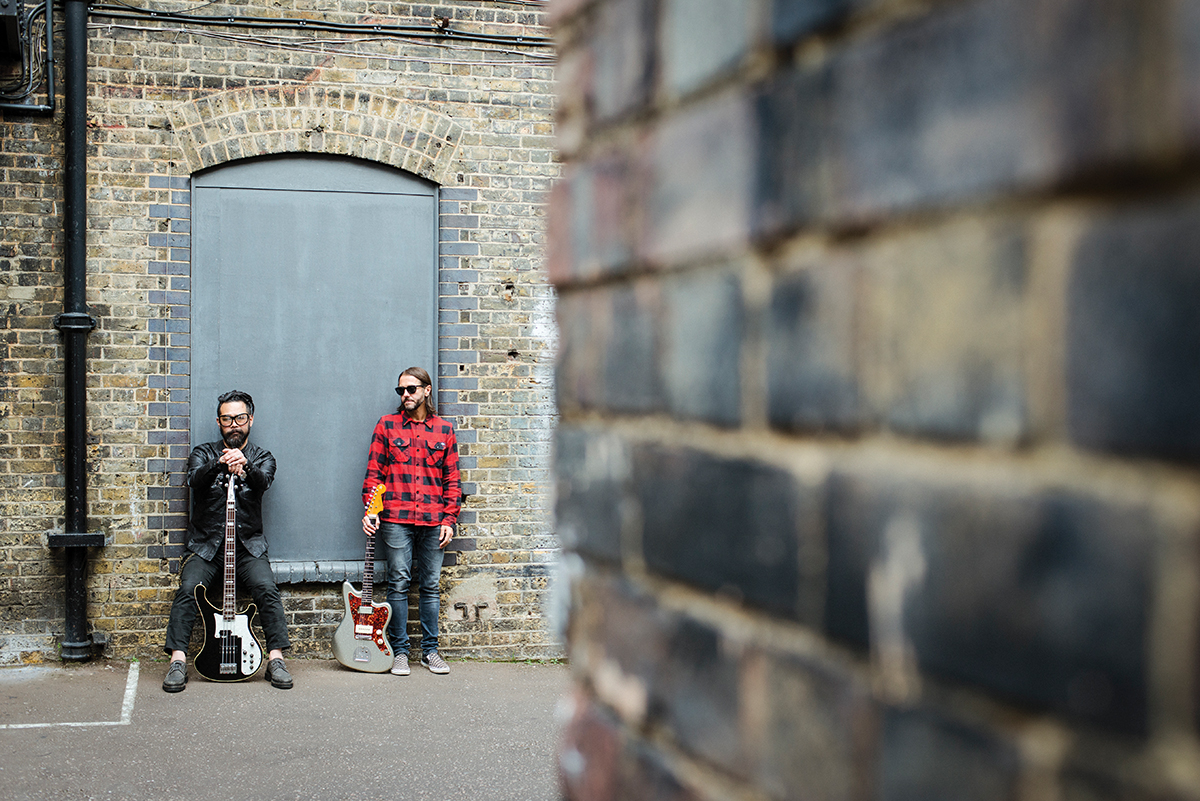
It’s been 21 years since Feeder released their first album, Swim, and over 25 since Newport friends Grant Nicholas and Jon Lee met Japanese bassist Taka Hirose in London, and set themselves on a path that would lead to top five hit singles, platinum-selling albums and major festival headline slots. “It’s a long time isn’t it? I never expected us to last this long!” jokes Taka. “Probably not!” adds Grant.
“It seems like a long time. But from the start, Jon and myself were very driven, and we were into it for a career – we didn’t want to just make one album and then disappear. We’ve always been more about the songs – that’s always been our goal. To be a band where it doesn’t really matter what people think at the time, it’s about having songs that are timeless, and maybe 10, 20 years after they were recorded they still stand up. That was always the plan and we’ve stuck to that – and that’s probably why we’re still here, I suppose!”
Despite the highs, however, the pair have also had to deal with great tragedy. Lee’s suicide in 2002 is the kind of devastating moment that many of us would struggle to get past, but Grant and Taka have been galvanised by their shared loss, “It being two of us has made us stronger, and feel more strongly about what we do,” Taka affirms. “Grant is always the driving force. If he’s not talking about a guitar, he’s talking about a song – and that hasn’t changed!”
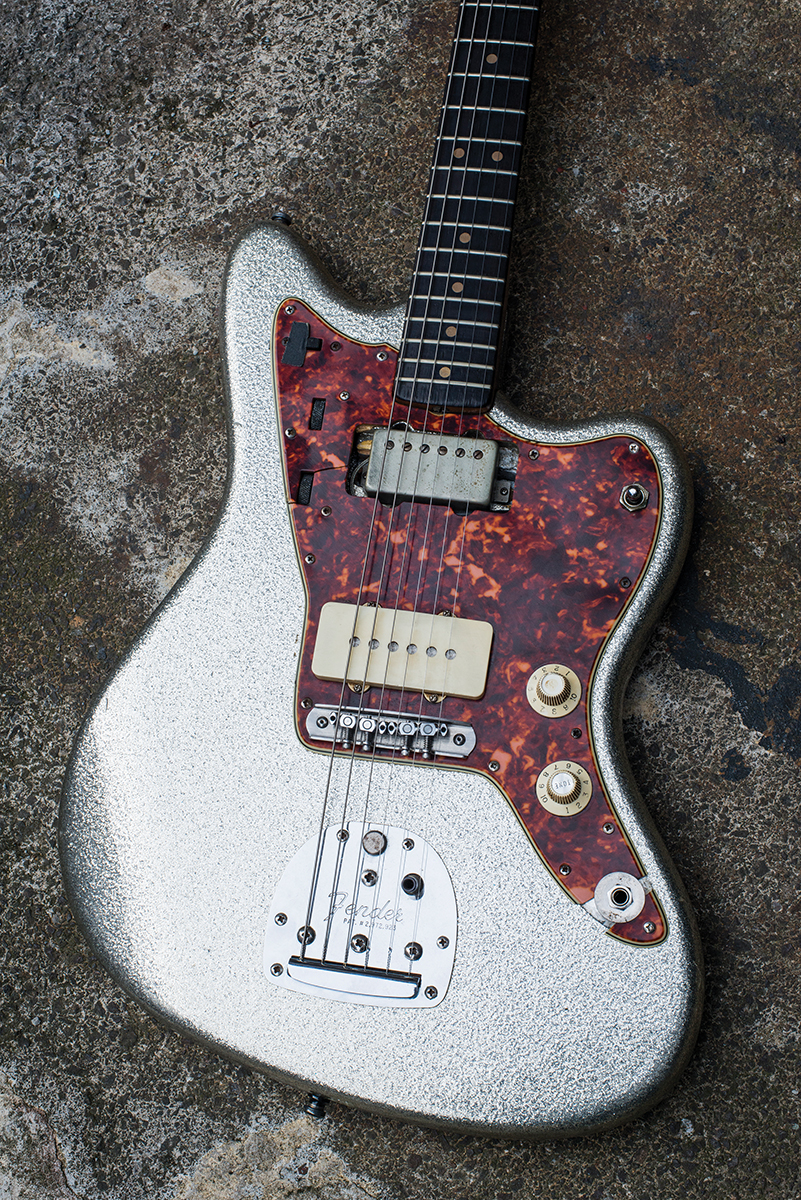
Comfort in sound
Talking guitar is what we’re here for, and it’s a subject that the pair both know very well indeed. Grant has a love affair with Jazzmasters that borders on the obsessive – and he came to Fender’s quirky offset at a time when not a lot of people in the UK music scene were playing them.
“No there weren’t really,” Grant confirms. “I just liked the shape. I was playing Telecasters, I had an SG… but the Jazzmaster appealed to me because they weren’t so popular then. My first Jazzmaster, I swapped it for like £200 and a Whammy pedal, and I just fell in love with the shape of it. I liked the fact that even though I’m not a big-framed person, I like guitars that have a little bit of weight to them, and also it being the longer scale. I love the Jag and the Mustangs, but the Jazzmaster just suited my playing more and suited my style. I mess around with them quite a bit – I change pickups and bridges and that stuff.”
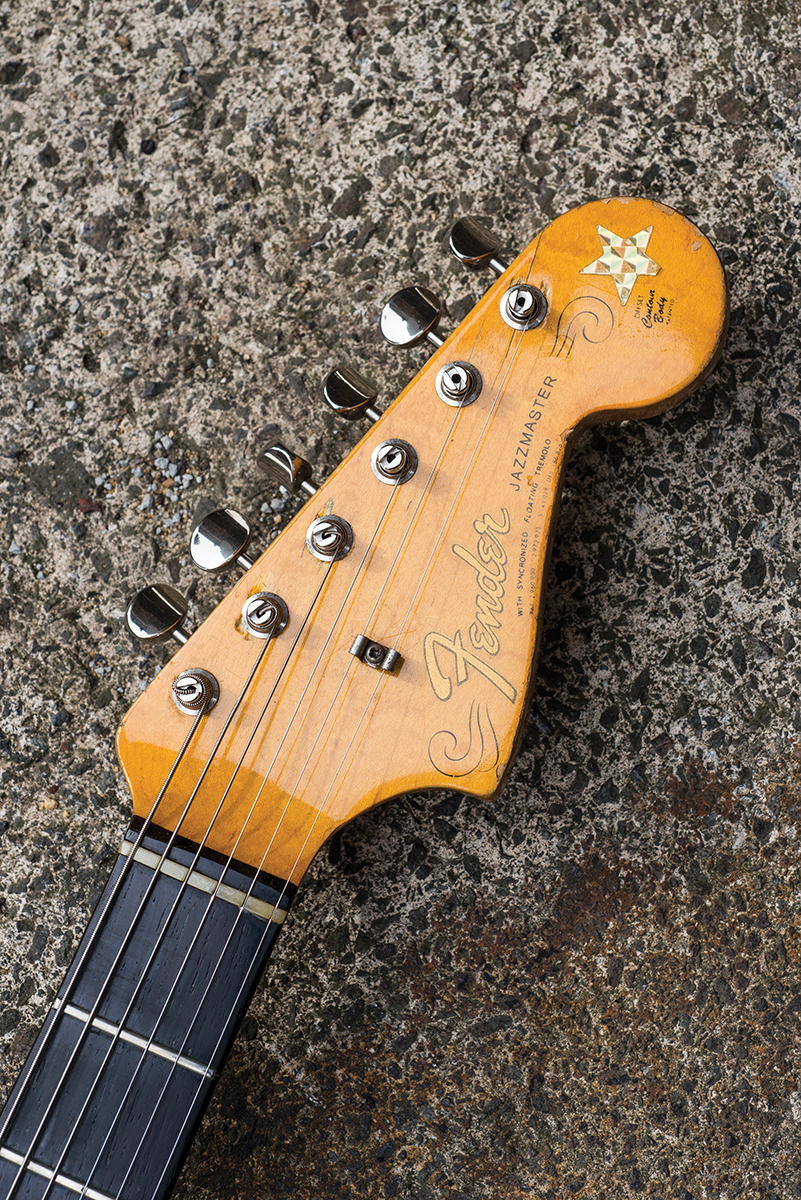
On the flipside, Taka’s bass collection is a fascinating mix of classic designs, boutique curios from his homeland, and most interestingly of all, instruments that he’s built himself under the brand ReBirth. It seems like an unusual thing for a rock star to do, but it makes sense when Taka shares the details of his pre-band career.
“After high school I worked at the ESP factory in the mountains for just over two years,” he explains. “I’ve loved making stuff since I was a kid, and I love guitars and bass… it was good fun! But I was young – 18, 19… living in the mountains when you’re that age it’s like, ‘How has my life ended up here?! I want to see the world!’”
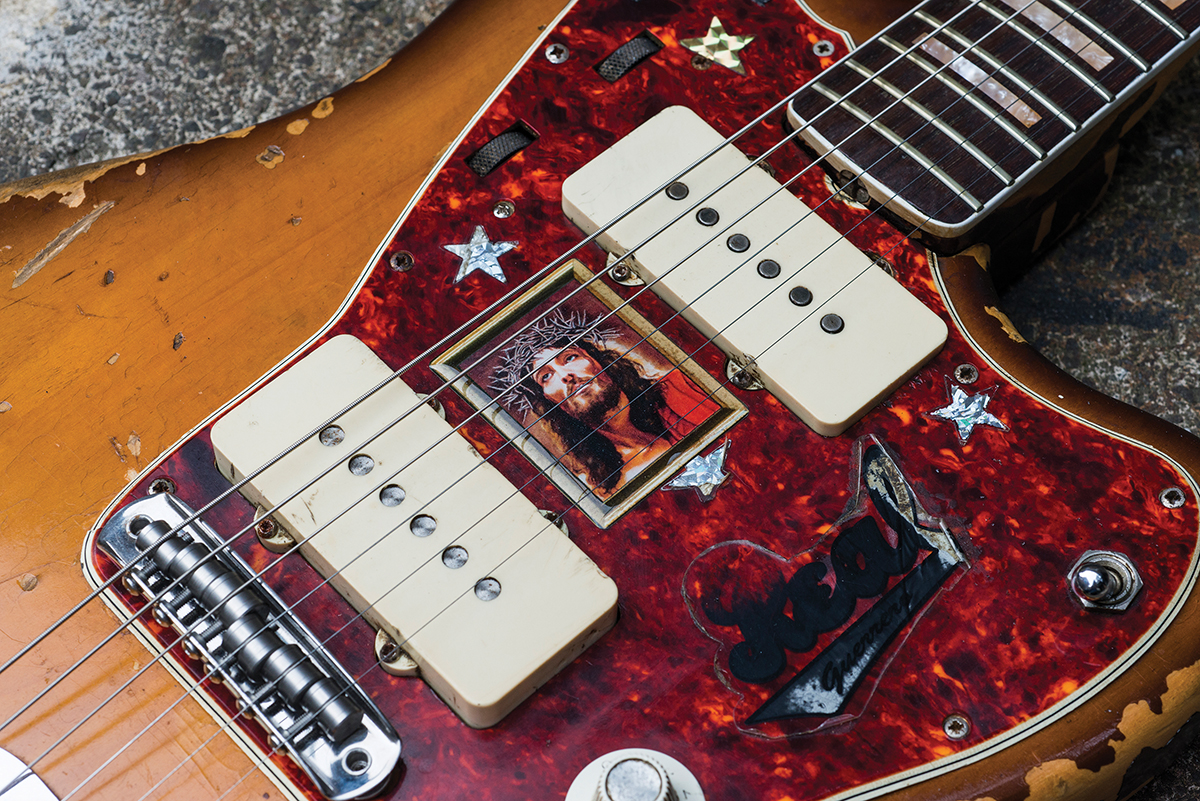
Picture perfect youth
Grant’s collection of guitars extends far beyond the instruments he’s brought with him to share with us today, but they’re the ones that mean the most to him, and there’s no more special guitar to him than his 1966 Jazz, affectionately known as ‘Old Brown’.
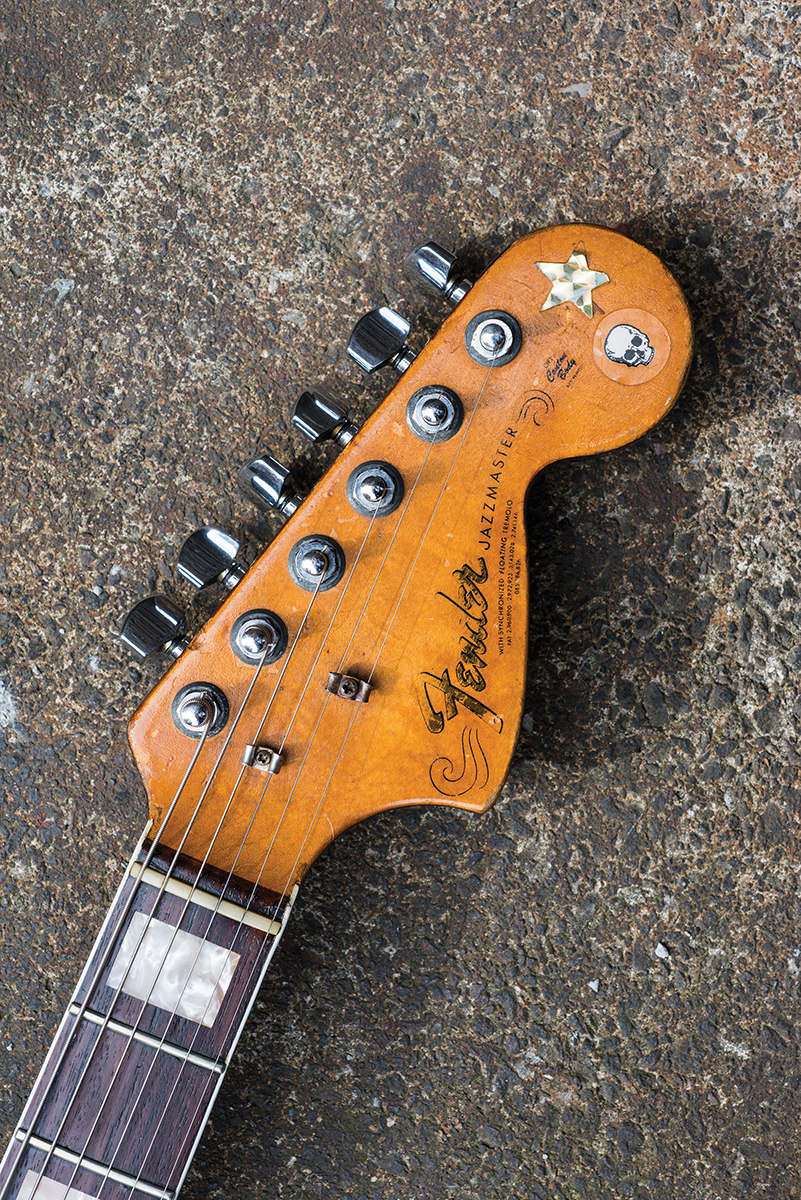
“Or Old Jesus as I call it!” Grant chuckles, in relation to the sticker between the pickups. “That’s my first one – the one that I did the swap for. It’s my most sentimental one – my ’59 is the one that I use for recording, but this is the one that people know me for, because that’s the one I’ve most used, and the one I used on the main stage of Reading back at the 90s.
“Old Brown is a ’66, but it’s a bit of Frankenstein, yet it’s got a great vibe. It was worn when I bought it, but I’ve certainly added a fair bit of wear to it over the years – it’s been thrown around a bit. It’s got a really lovely neck, it’s got a great sound and I really love the square inlays and the binding on the neck – that’s my personal favourite era of Jazzmaster, with the big headstock. It’s got a lot of character, it plays really well.
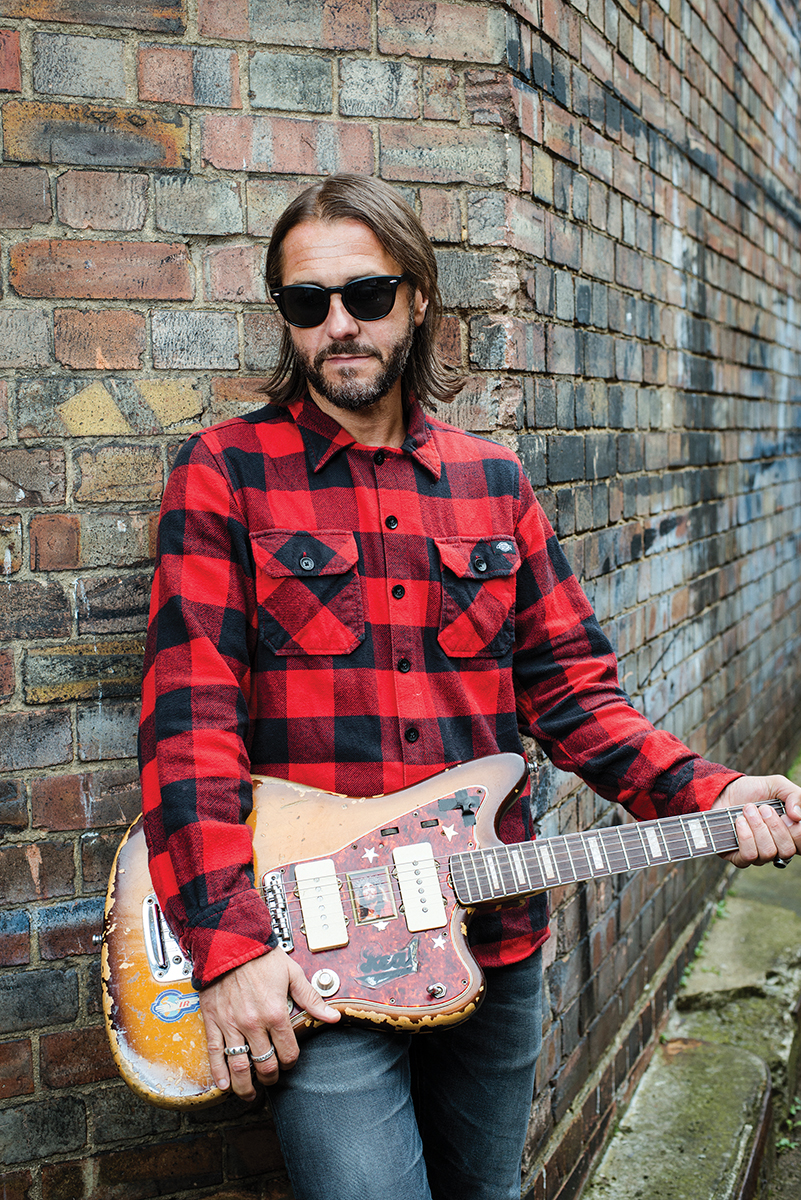
“The pickups I use live in all my Jazzmasters are Seymour Duncan Quarter Pounders, because they give me that really fat sound. I’ve used other pickups, but the Quarter Pounder for me just covers a lot of ground in Feeder – I had humbuckers in there for a while, I had a JB in the bridge for a while when I was using my amps in a different way, but now I’m mainly on single coils it’s difficult to switch to a humbucker guitar when the amp is set a certain way.
You can get away with it on certain things, but the Quarter Pounder in the Old Jesus is pretty much my signature sound. It’s got a lot of tones in it, and I’d be absolutely devastated if it ever got nicked or anything – it’s an old faithful. Everyone has that guitar, don’t they? Most of the guitar players of my era had that one guitar that’s the one, with Neil Young and his Les Paul, and that’s my signature guitar.”

Tinsel town
Another of Grant’s signature guitars is a 1964 model that’s been finished in eye-catching silver sparkle finish. “It’s another iconic guitar for me,” he enthuses. “That’s on a close par with Old Brown because I’ve had it almost as long. It was originally like a dirty white colour. It’s a ’64, but again that’s got a Seymour Duncan Antiquity in the front and a Quarter Pounder in the bridge. I think it had two humbuckers in it at one point. Then when I moved back to single-coils I swapped the bridge out but I kept the neck pickup, because it really has that really fat, really creamy sound that I need for some of the solos and guitar lines in Feeder, so it’s just nice to have one that does that.
“For example, there’s a song called Turn that has this really filthy guitar sound on the solo, so to compensate for that I hit the front pickup and it gives that fat, saturated sound. So yeah that one’s called Wales, and I’ve had it for a long time – I actually had it refinished in that silver sparkle, and that’s kind of become another trademark for us. I’ve actually got two matching ’64s in silver sparkle, but this is the one with the most history.
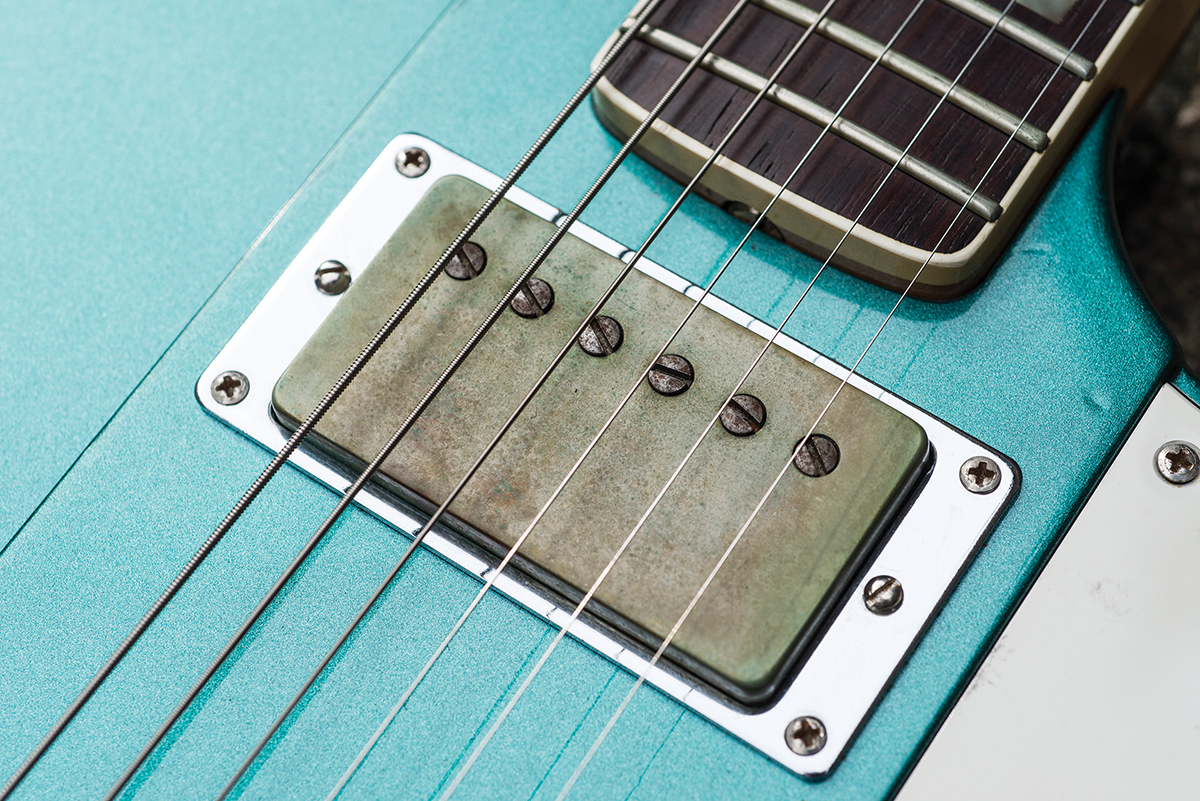
“That one’s got a Mastery Bridge in it – Old Brown has got a Staytrem. They’re really good – I was just buying the Mustang bridge online from Fender or Allparts, but when I tried the Staytrem I was really impressed. It’s probably my favourite bridge to use as a replacement. I’ve always changed my bridges to the Mustang-style unit, because it’s better for live use, and also I tend to fix all my bridges so they don’t really move. It’s just better for tuning.
“Staytrem do one that has a thicker post that’s more of a fixed one… but I only found that out afterwards! So I wrap copper tape around the posts so it’s really wedged in there. It’s the sort of thing I’ve done since I started playing them in the early 90s. It’s quite hard to find, you buy it in art shops.
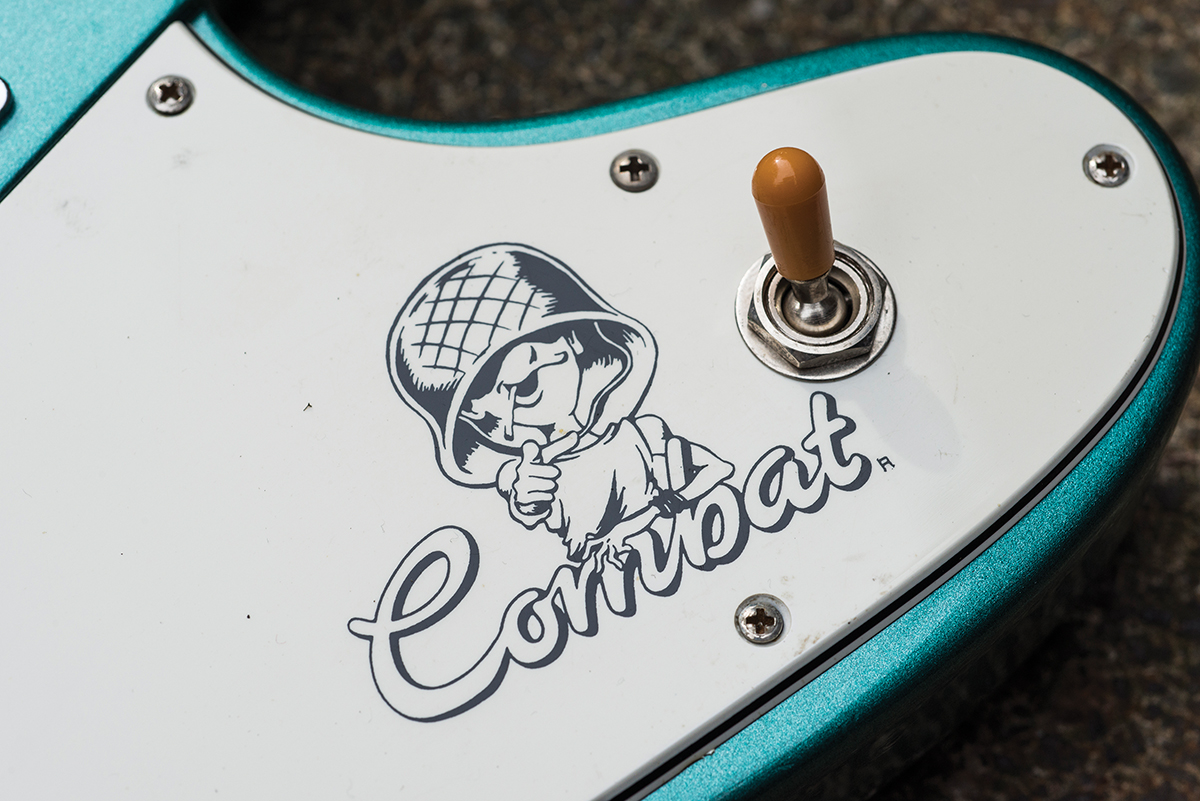
“The ’64 and the Old Brown were my two first Jazzmasters. It’s been used on everything as well! It’s a beautiful guitar to play, it’s got a lovely feel. It’s got a little bit more weight in the body than old brown, but it’s an absolute corker guitar, it’s got a beautiful neck. You know you get some Jazzmasters that just feel better than others – even if you buy a vintage one they don’t always feel as good, but they all get better with a bit of wear, y’know, because it’s been played. Any guitar just gets better wear I think.”
Quick fade
Grant clearly has a thing for sunburst Jazzmasters, but his late-80s Japan-made example has seen a bit more abuse than it might initially appear. “That’s got a real history to it,” Grant remembers. “God, we’re going back a long time ago… I bought it in Japan, and it was cheap. It was a nice guitar to play, and I think I used that guitar at Reading at one of our big main stage appearances. If you look at any of the early Feeder footage, it used to have an oval Feeder sticker on the top of it.
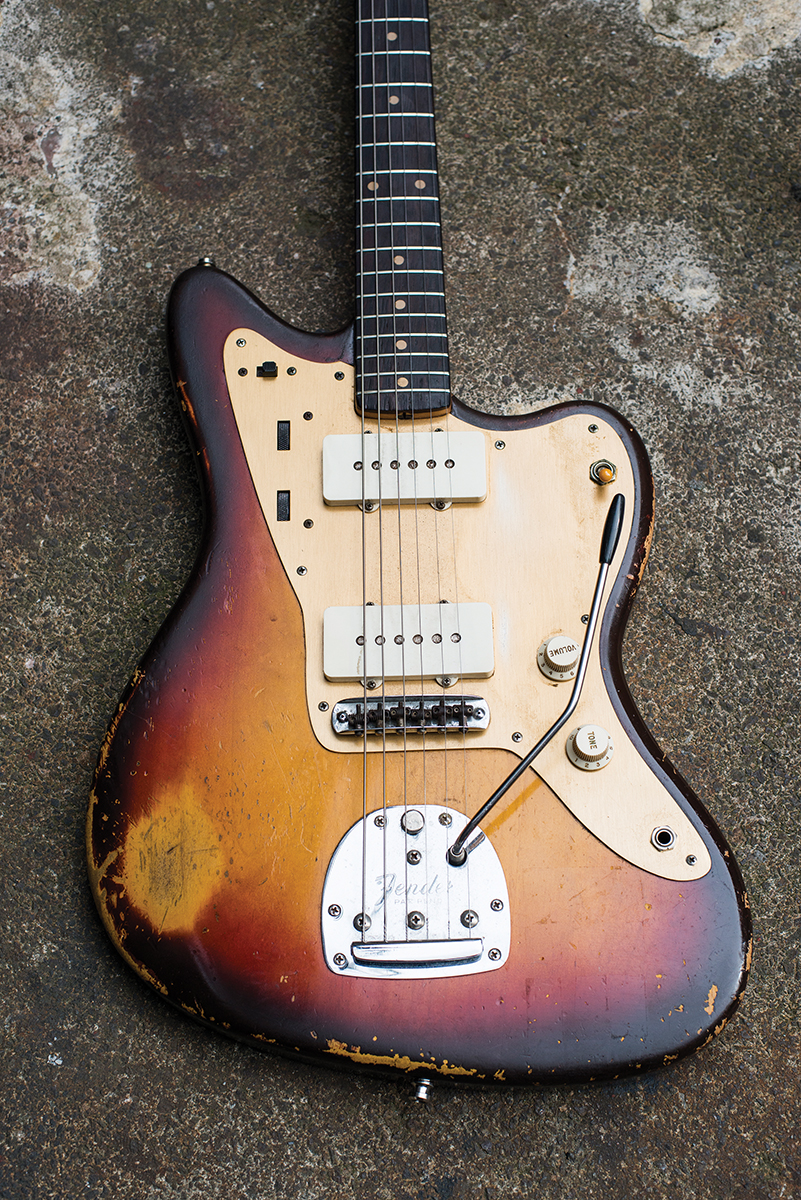
“Basically what happened was that it’s been completely trashed over the years! I took the neck off it, and put the neck on another Jazzmaster, I don’t know why I did it, but it was just this body that’s been living there for a while – this body with a broken scratchplate. I think I might have smashed it and thrown it against the wall a few times to make it look a bit more messed up for the Renegades video. But yeah, to cut a long story short, Taka started doing this thing called ReBirth Guitars, and that was one of his first experiments.
“So I gave him a body, some pickups and a scratchplate. And then for the neck… when Feeder headlined Download Festival it was a pretty big gig for us, but it was a tough gig, and I remember getting really frustrated. I don’t know what came over me, but I basically trashed over two and a half grand’s worth of Jazzmaster on stage. I don’t know what happened to the body, but I was left with two bits and a neck, which had a big crack in the headstock, which you can still see. So Taka put some screws in it, glued it, aged the neck, and put it all together for me – so that’s the story! It plays really well, and it looks really cool.”
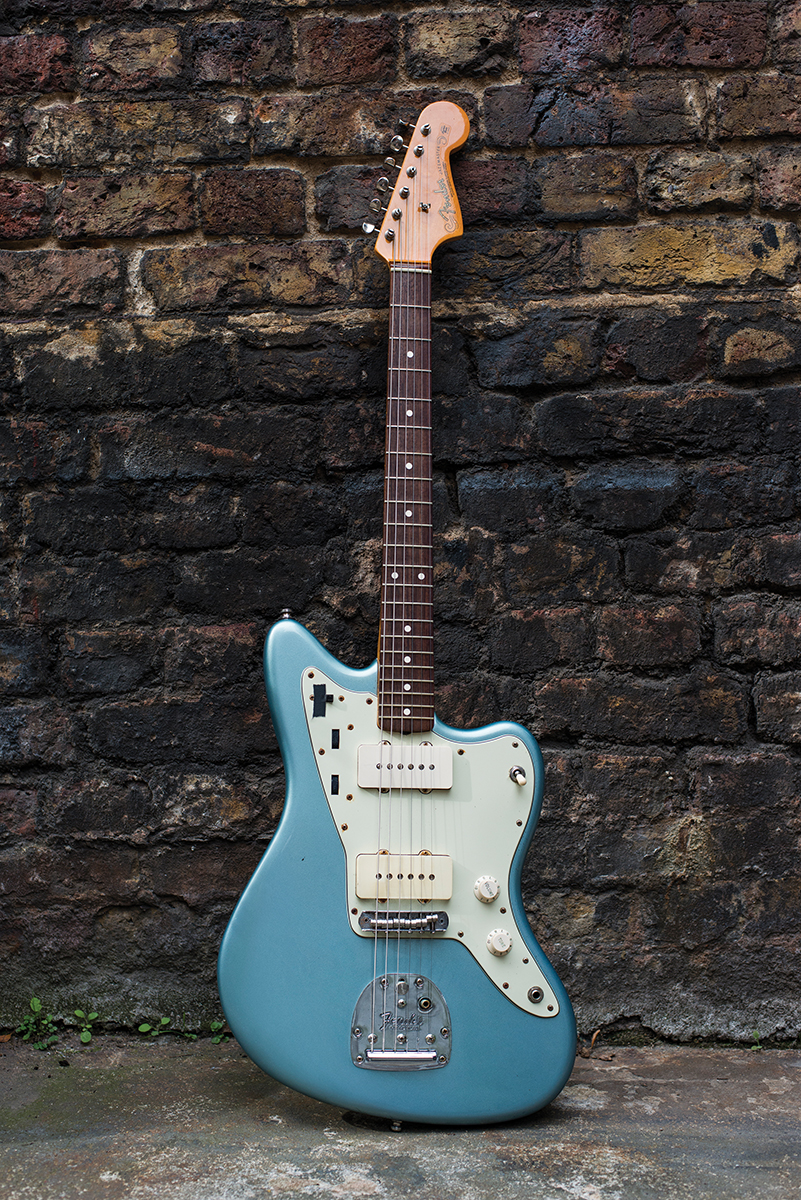
Trashing his lovely new Jazzmaster on stage did have an upside, however, and it can be found in the blue Jazzmaster he’s brought along with him. “This is basically a standard US Jazzmaster,” he explains. “Neil Whitcher at Fender and the guys… they heard about me trashing my Jazzmaster, and because I was endorsed by Fender, I thought I’d be in big trouble! But they came when we were supporting REM in Hyde Park, and turned up with that in the case and were like, ‘This is yours, you can keep it’. And I was like, ‘Oh my god how lucky am I?! I trash a guitar and they just give me another one – I don’t deserve it!’”
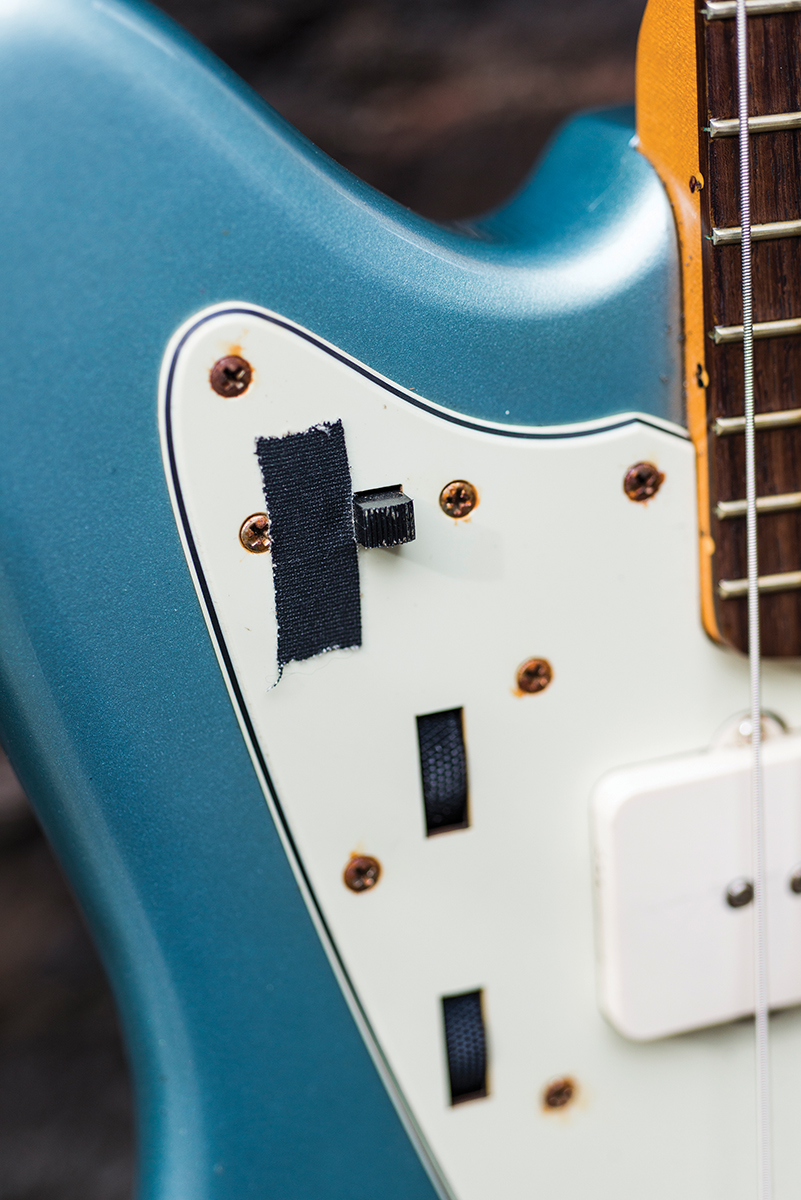
You’re my evergreen
While some of his Jazzmasters have more sentimental value, there’s one guitar that is without question his favourite instrument, and one that is always his first call in the studio – his Sunburst ’59.
“That’s my holy grail – it’s an all-original ’59,” he enthuses. “I got that after the success of Comfort In Sound – me and Taka went down to Vintage & Rare and he bought an old Jazz Bass. It was outrageous, I think I bought like three guitars in one go! The ridiculous thing is that it wasn’t even that expensive – it was a bargain. It’s got the original case and everything. It’s just a beautiful guitar. I haven’t changed the strings on it since Generation Freakshow, because I just love the sound of those dead strings. That’s the guitar I use most for Feeder recording – even for the heavy stuff, it’s on virtually everything.

“That guitar has got so much character. The trem is working on that one, in case I want to do any crazy rockabilly stuff. It needs a refret really, but I’m scared to mess with it because it sounds and plays so good. I’ve used it in videos, obviously, or if we did like, Jools Holland or something – but otherwise it just lives at home! Since Comfort In Sound that’s been the most used guitar for all the Feeder stuff, and my solo stuff as well.”
It’s not all Jazzmasters in Grant’s collection, however – he’s got a variety of classic and esoteric instruments to call on, including his battered early 70s Sunburst Tele.
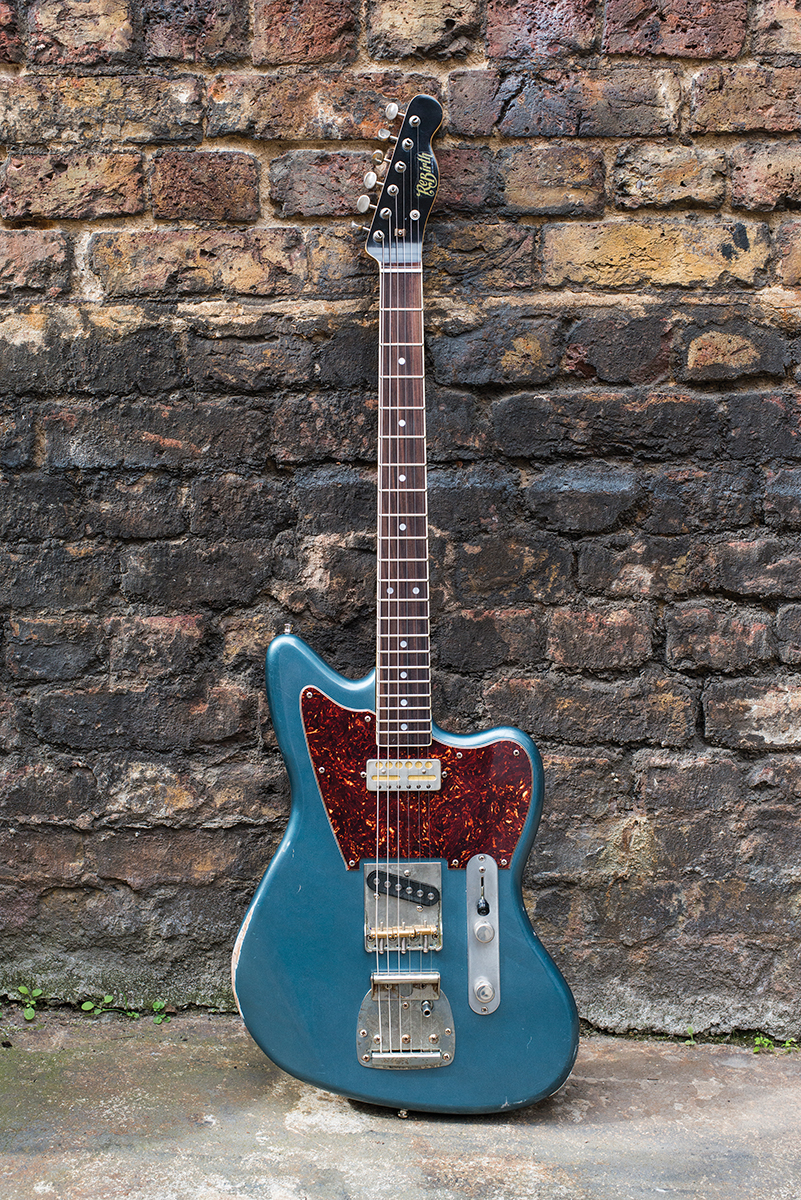
“That was one of the guitars that I got at the same time as the ’59,” he recalls. “I’ve always loved Teles. They’re solid, they sound great and I love that beaten up Sunburst. I always loved Andy Summers, so when I saw that and I played it I thought, ‘Well this is just brilliant’. When you see the right one that’s the right weight and all that, you’ve just got to snap it up because they’re getting hard to find these days. They just get better with age. Teles are just great guitars, solid, reliable – I love anything that’s sunburst and has a bit of character – I’ve always been a bit of a sucker for it.”

Just the way I’m feeling
Grant clearly likes his classic old Fender designs, and with that in mind, the presence of a Gibson Explorer might be surprising, but again it comes from Grant’s affinity for playing things that are a little bit different…
“When I bought that guitar I was with Taka, we used to go to this guitar shop in Richmond quite a lot, and this guitar was just there for sale. And at the time no-one was really playing Explorers unless they were in a metal band, but I quite liked that, and it was a cherry one as well, so it didn’t look quite as metal.
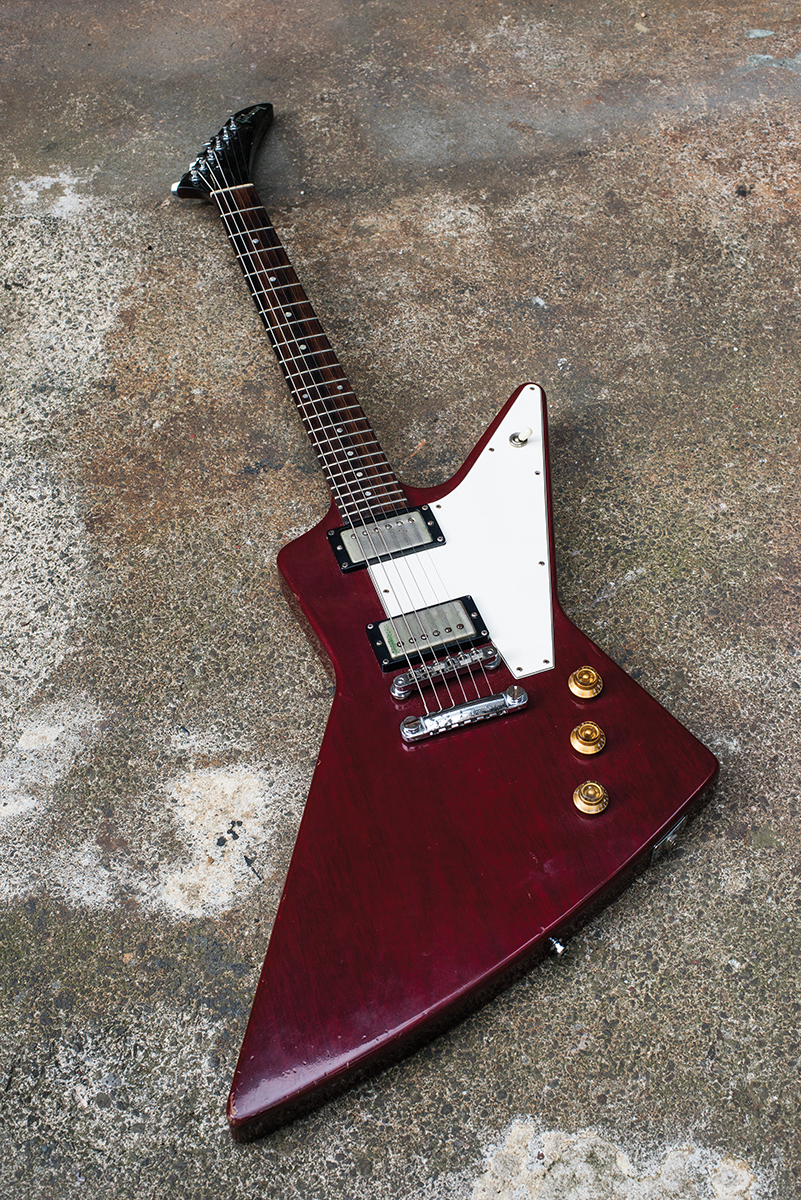
“It originally belonged to Mick Ralphs from Bad Company apparently. Well it had his name on the case, and that’s what they told me! I haven’t touched anything with it – the pickups are Seymour Duncan Antiquity humbuckers in there – they’re my favourite humbuckers actually. It’s been used since the Polythene period really – it’s been used on practically every Feeder song since. It just plug it straight into a Marshall and track it, it just does that one thing – it just rocks.”
Perhaps the most interesting Jazzmaster-style instrument in Grant’s collection, however, is another of the fruits of Taka’s ReBirth project –a full custom build that he calls the TeleMaster. “He’s got a bit of a taste for it now!” Grant jokes. “He made this one for me that’s basically a Tele-Jazz idea, similar to what the Custom Shop was doing with the Offset Tele, but I asked him if he could make me one that is more faithful to the Jazzmaster look.
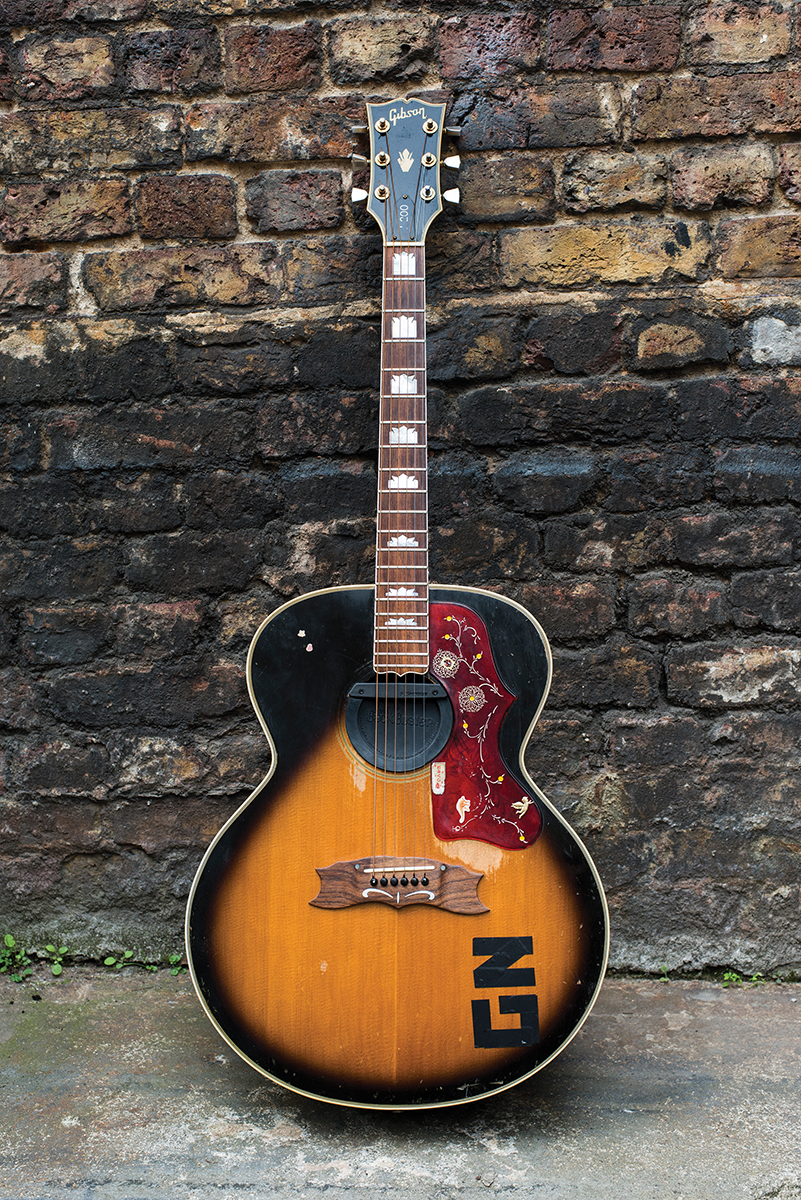
“He’s put the Mojo Pickups Gold Foil in there, but I haven’t got my head around all the pickups yet. It suits my sound, because I love the Jazzmaster shape but that Tele sound is a really important one for me – so it’s good to have something with a bit more character than just a standard Tele all the time. I am going to start using them more. He’s done another one that’s a sort of Firebird/Telecaster which is really nice – it’s got a mini-humbucker on the front and a Telecaster pickup on the bridge, so I’m going to start using that as well. I think he’s taken on board all the stuff that I’ve liked over the years!”
Space Age hero
The final electric in Grant’s collection is another esoteric instrument – a Firebird-meets-Jazzmaster hybrid made by Combat Guitars in Japan. “This was made for me by a friend of Taka’s that used to work at Combat – they were a small company in Japan,” Grant explains. “I wanted something that was a cross between a Firebird and a Jazzmaster, so I named it the Jazzbird, and it’s kind of a one off. I wanted the Jazzmaster trem, the big headstock, the square inlays in the neck, and I wanted the body to be thicker than a standard Firebird because I wanted a bit more weight and a bit more balance as well.
That’s the problem with Firebirds, unless you move the strap button they tend to lean forwards – they look cool but they’re not the most comfortable things to play.
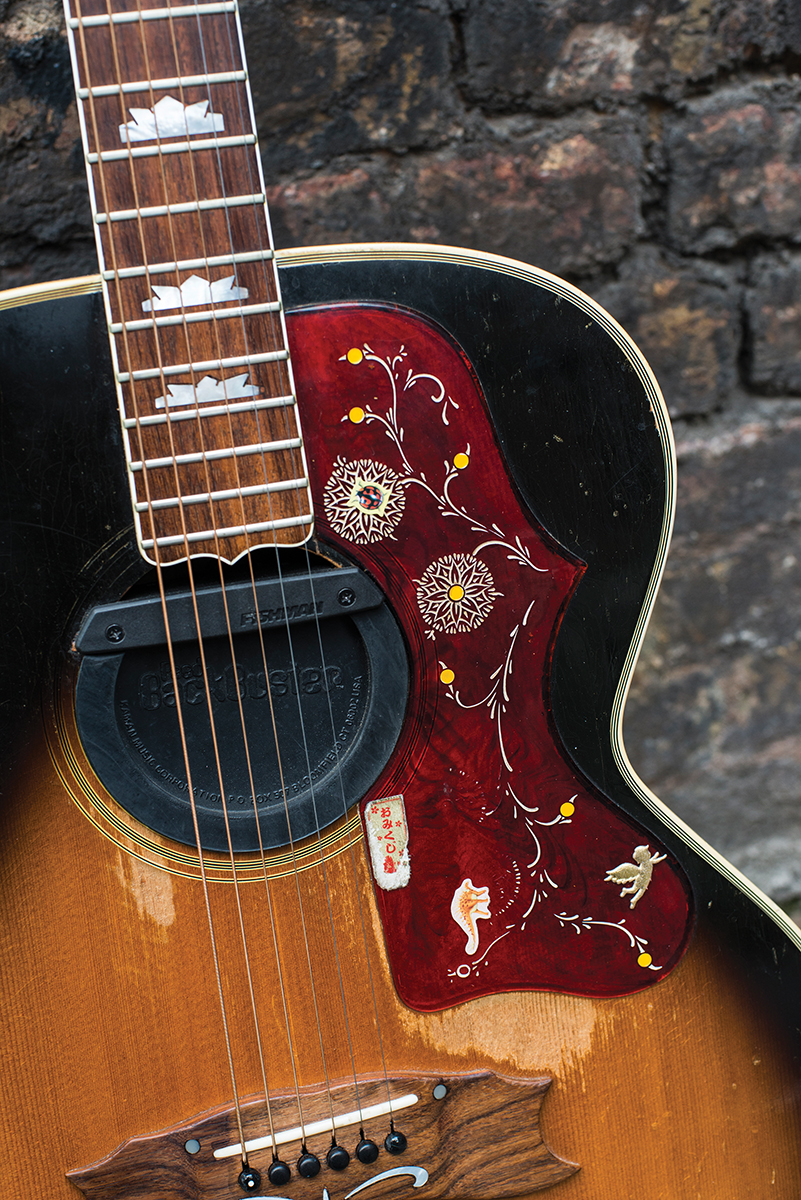
“The original had two Tom Holmes humbuckers that sound fantastic, but I recently changed the bridge humbucker to a Seymour Duncan P-90, but in a humbucker casing. I haven’t really had time to get to grips with it yet and I’m not sure it’s the right one, but I do want to get it back out in time for the hits tour, because that’s what I’m using on our singles album sleeve and in the Come Back Around video, so it feels wrong to not to use it for something!
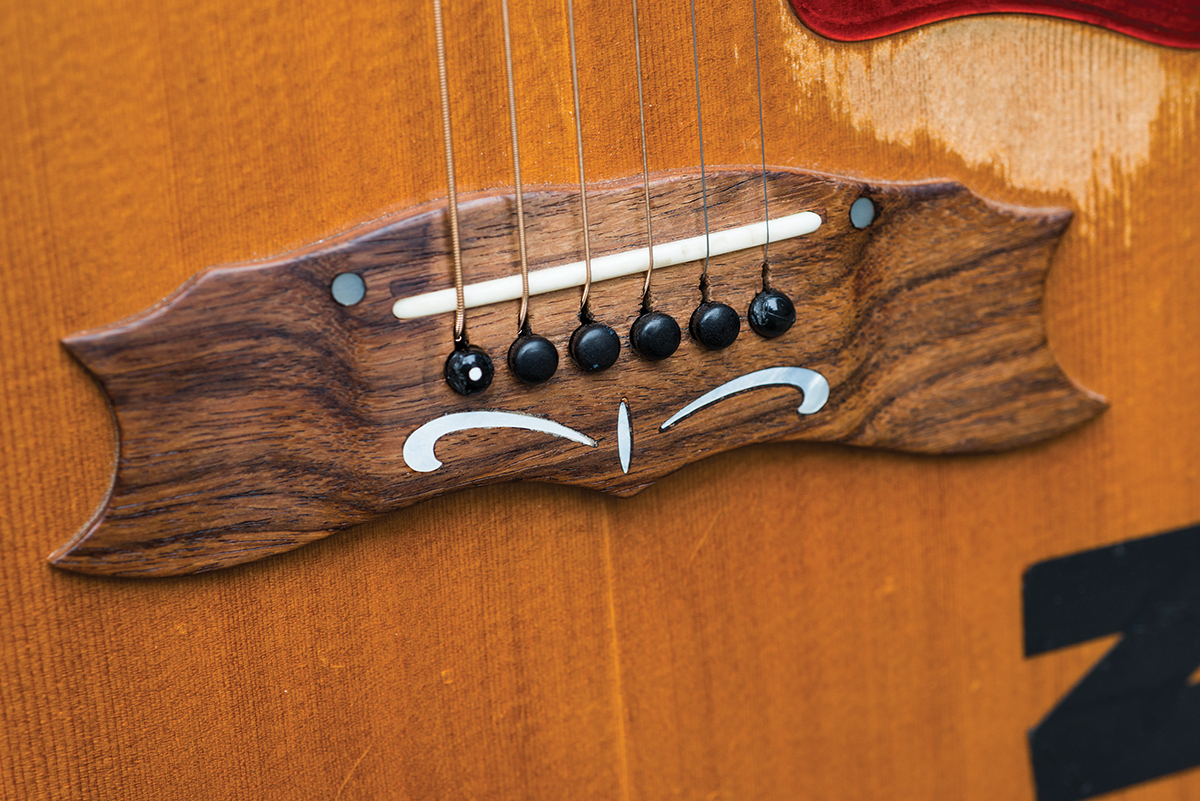
“I think this was also one of the guitars where Taka got the idea for his ReBirth stuff from. He said to me, ‘Do something different!’ because I always basically say, ‘Yeah, can you make me a Jazzmaster?’ – because that’s basically all I really want! But he was adamant that I should do something different. ‘Oh okay, I like Firebirds… so can we make it maybe half Firebird, half Jazzmaster?’ [laughs] I’ve had a few lovely custom guitars I’ve had made for me – I’ve got this beautiful ESP that’s half SG, half Mustang, but I could only bring so many guitars with me today! It’s a great guitar that, and it looks cool!”

Silent in space
It’s not all electric guitars in Grant’s collection, however, and when it comes to acoustic, Grant has a few key instruments he uses for live work and songwriting.
“I write pretty much all of Feeder’s stuff either with the ’59 or with one of my acoustics,” he confirms “That’s what I’ve always chosen to write on. My Guild is an M-20, I’ve got two of them – I’ve got a ’64 and a ’65, that one is the 1965. I absolutely love those guitars, they’re so good for fingerpicking. Again I hardly ever change the strings because I like that organic, dead sound for fingerpicking.
“If you ever find an old Guild M-20 for a great price, buy it immediately because they’re great guitars and a good investment, but they’re getting harder to find. When I got it, it blew away any other acoustic I’d tried. It was great for my solo stuff [Grant’s 2014 Yorktown Heights album] because it’s great for fingerpicking and rhythm stuff, too. It’s also probably the best sounding recorded guitar I’ve got, even though it’s got the smallest body. It’s an amazing guitar, it’s all mahogany so it’s got a real dark tone to it – I’m not into sparkly sounds, I’m into organic, earthy, been playing it for 50 years and haven’t changed the strings kinda vibe.”
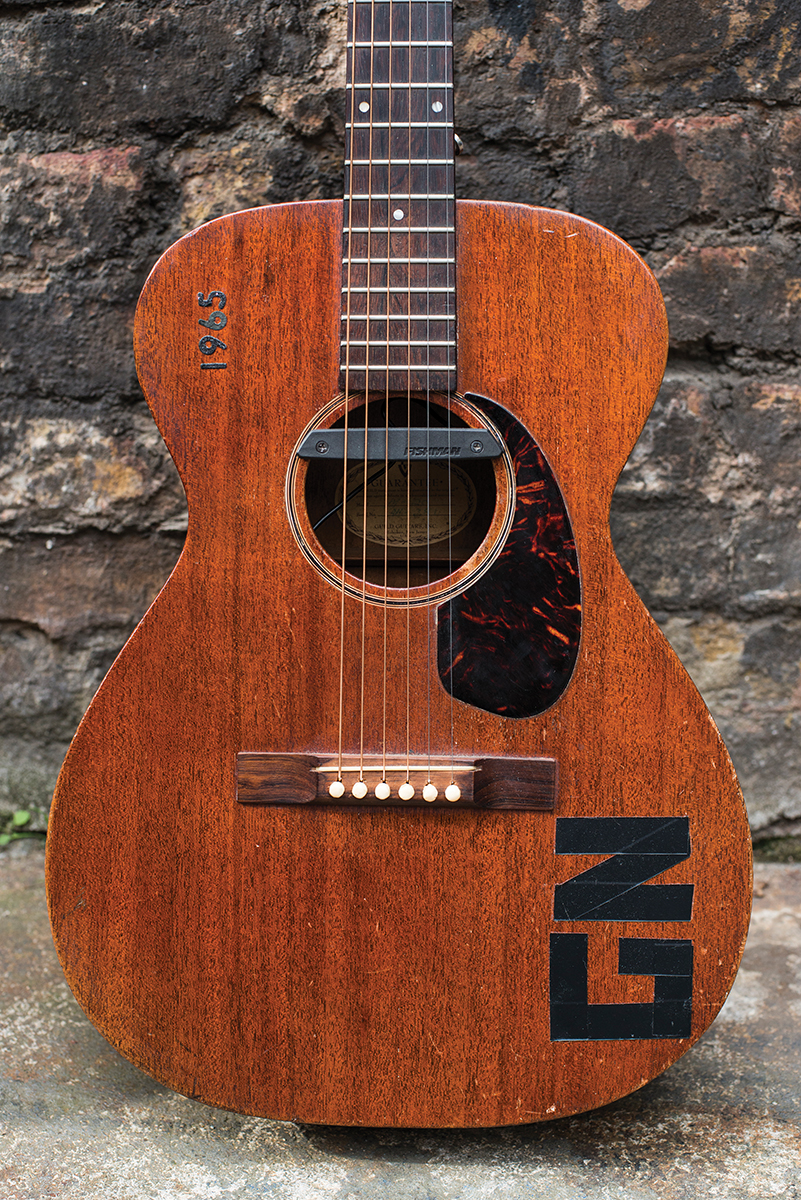
Grant’s most famous and commonly seen acoustic is his old Gibson J-200, but it’s an instrument that came to him by a stroke of luck and some trust in a dodgy hotel…
“I was on tour in the US with Everclear and we did a gig in Idaho,” Grant remembers. “We went to a vintage guitar shop and I saw it there, and I fell in love with it. I didn’t have enough money at the time but it was really cheap… crazy cheap. It was like 500 dollars or something. And it had the original case with a handle that looked like somebody’s belt, loads of stickers on it and the bottom falling out. It just had so much character to it. I remember thinking, ‘Oh I really want to get it but we’re a bit tight for cash’.
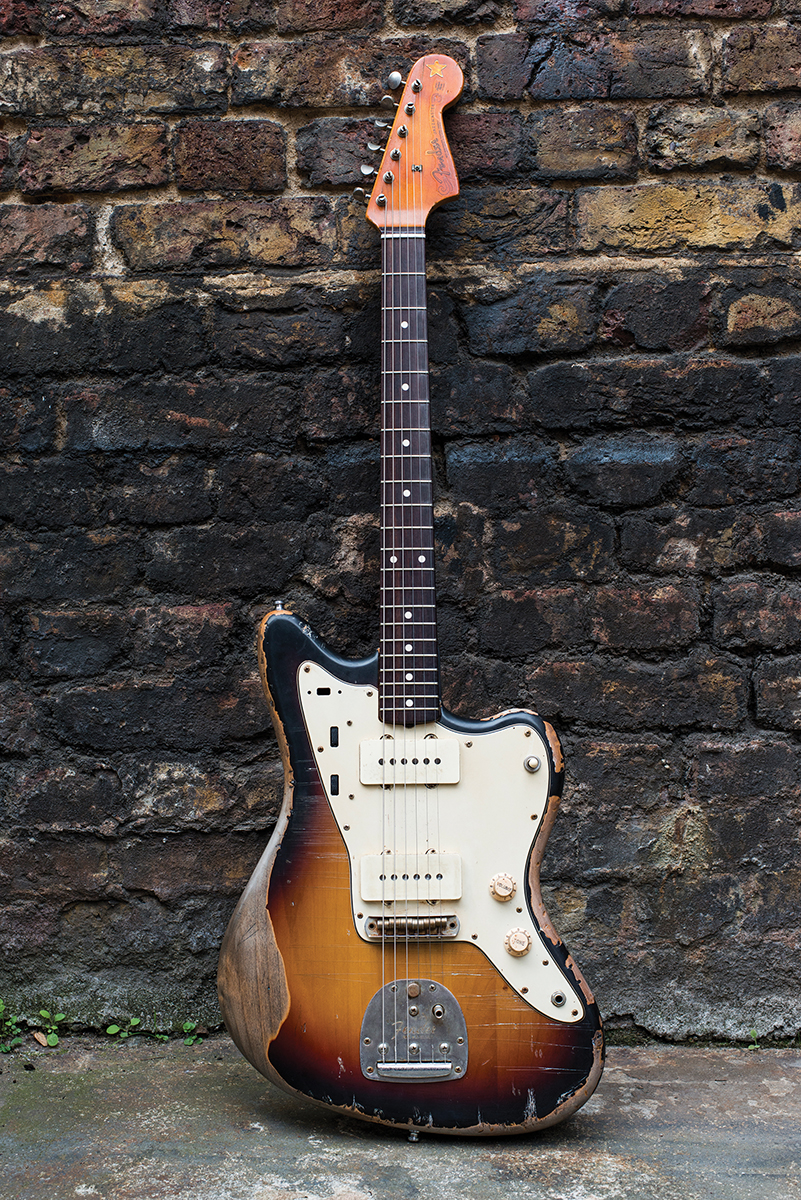
“Then, about three gigs later, I think we were in Texas, I called them up and said ‘Have you still got that J-200?’ ‘Yeah man!’ ‘Well then I’ve got to buy it!’ I think I put it on my credit card, and I said, ‘Well we’re going to be arriving at this shitty hotel in a week’s time – can you post it to me there?’ And they’re like, ‘Sure man we’ll send it through’. And I’m thinking, ‘Christ is it ever going to turn up?’ But then we got to the hotel and there’s this massive cardboard box and it was there, and I’ve had it ever since. It’s a great guitar – as much as I love a small-bodied guitar, I also love that Elvis/Johnny Cash thing that the J-200’s got, they just look rock ’n’ roll don’t they?”
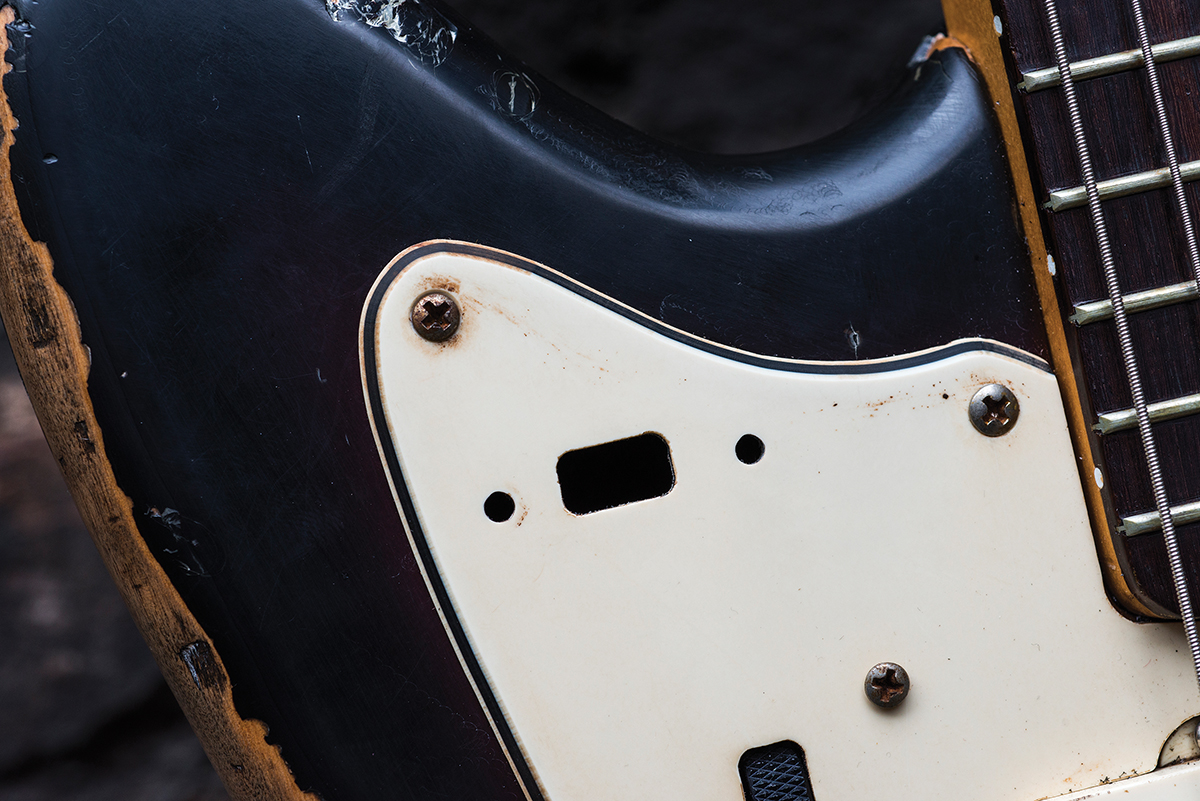
We are the people
When it comes to discussing Taka’s collection of bass guitars, there are three distinct categories that he favours – vintage classics, boutique one-offs and the guitars he’s built himself. But the common theme running through all of them is a reverence and love for classic designs, and it’s something that Taka learned when he was a teenager working at the ESP factory: “Some people there wanted to make things that were almost like furniture, very ornate,” he recalls. “But for me I always ended up back with the classic Fender and Gibson stuff.”
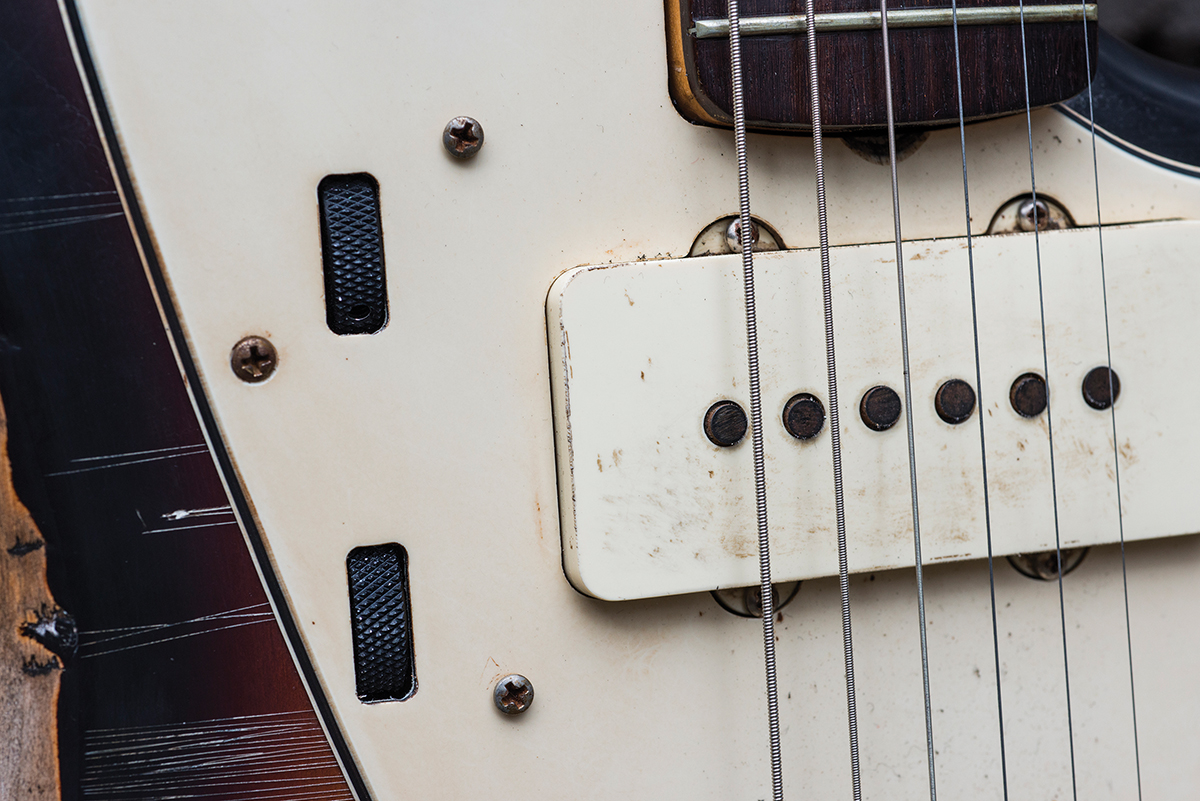
It’s hard to improve on the classics, and that’s exactly what Taka has in his 1968 Jazz Bass. “Before a gig one day I was in second-hand music shop, and tried this Jazz Bass,” he tells us. “It was so nice and so good – but I didn’t have time to buy it because I had to go back to the venue to do a soundcheck, and I never got it!
“So from then on I’m thinking, ‘I wish I’d bought that’. Then when me and Grant went down to Denmark Street after Comfort In Sound was a success, I was determined that I was going to find a Jazz Bass! So I found this 1968 model that was in great condition. I love everything about it! It was the same day as Grant bought his ’59 Jazzmaster – he wasn’t sure about that it, because it was a bit old-school for him, but I was like, ‘You’ve got to buy this – it’s a ’59!’ [laughs] We got a discount because we bought them together!”
There’s another classic-looking Jazz-style in Taka’s armoury, but it’s not quite as vintage as it looks… “One of my mates was still working for ESP at the time and he emailed me, ‘Taka
I’ve just done a nice old Jazz Bass body and neck…’” he remembers. “I was like, ‘Ooh that would be nice!’ But I asked him to make me a Jazz with precision pickups, which is why it’s got the big pickup cover on it – it’s actually a Precision pickup on the front and a Jazz at the back. So that’s my main recording bass. It was great, because as soon as I had it, it had that feel of a vintage instrument.
“That one has active pickups and it has kind of like a parametric EQ. I like to be able to tweak in the studio, so it’s perfect for me, and very powerful as a recording tool.”
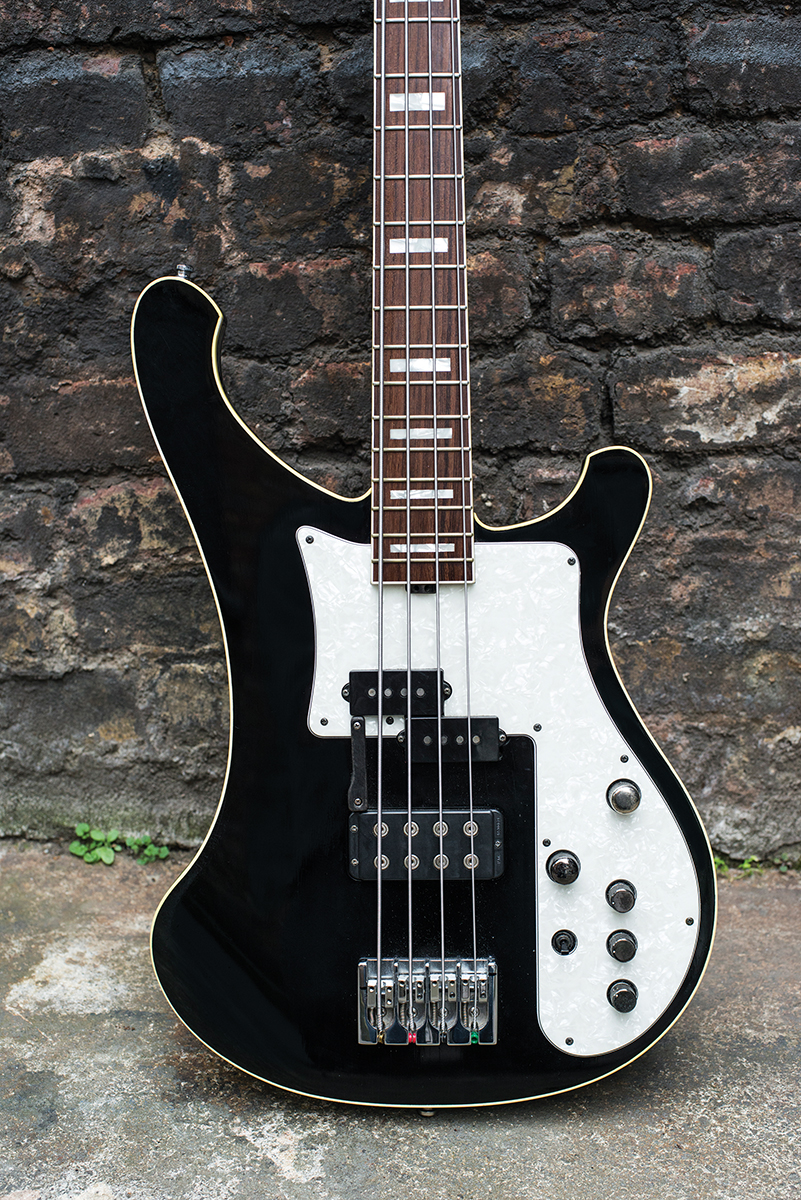
Renegades
Two of Taka’s most famous and familiar basses are a good deal more unique, and have also come to him through the friendships he made in his time at ESP, and the most famous one of all is his gold sparkle Combat bass, which he used at the height of Feeder’s chart-troubling success.
“Unfortunately the C on the headstock logo has gone, so now it’s ‘Ombat’” he chuckles. “Another friend of mine started to work for Combat, and I asked him to make a bass for me. I had a semi-acoustic Gretsch bass that I always loved, and I used it for videos a lot, but I can’t use it live because it’s fragile and has no bottom end.

“So I asked him to make me the same body, but solid! [laughs] It’s an ash body, but yeah – it is quite big when it’s a solidbody! The controls are the same as on the ESP bass – it has the same active circuitry. It’s also got a Jack Nicholson sticker on there – I think when we were playing on Top Of The Pops, the director was like, ‘Oh you have to hide your sticker, you can’t show it.’ I was like, ‘Really!?’ So I borrowed some tape and put the tape over his eyes… ‘How about that?’ And he was like, ‘Yeah… that’s actually okay.’ So it’s been there ever since!”
Another of Taka’s customs is a Ricky-style bass made by Kazu Guitar Village. “Kaz is my guy who used to work for ESP, he made loads of basses for me when he was working there,” he explains. “But then he left and set up his own workshop. When he was at ESP, I always used to ask him, ‘Please make me a Rickenbacker-style with my spec!’ And he was like, ‘…No.’ Because he was working at ESP and he would get in trouble! So straight away when he started I was on to him and said – ‘Now you can make it!’. And in fairness he was like, ‘Okay… but only one though!’
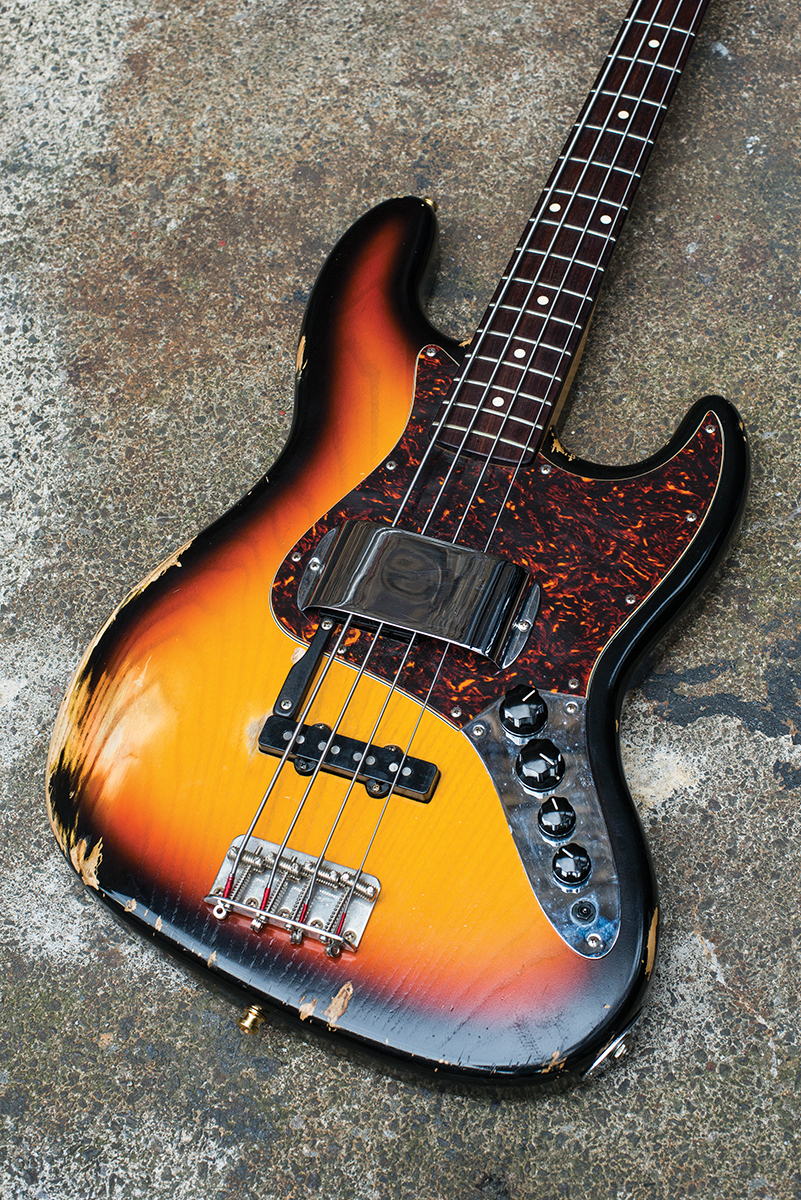
“I love Rickenbacker’s design, and it’s got such a characterful sound, but it hasn’t got that fat bottom end that I need for gigs. So that’s why I put the Precision pickup and the humbucker in there – it’s a bit more powerful. My favourite pickup is the Precision pickup – it’s just great for rock, well, it’s great for anything, but for Feeder the Precision pickup is perfect.”
Piece by piece
As you’d expect for a four-string stalwart, ReBirth isn’t just about guitars, and the black relic’d P-bass style bass is his self-made weapon of choice. Clearly he’s hit onto a cool recipe that smashes together classic designs with top-end parts and cool paint jobs – but we have to wonder how he got into building guitars again?

“Well, one by one my friends left ESP or the guitar business or whatever,” he says, “And then Kaz, because he’s independent, he can’t give me a freebie any more! When he used to work for ESP it was all, ‘Oh Taka I made this – take it!’ But now he’s independent he can’t, so I thought that I should maybe just do it myself!
“I started out just customising because I didn’t want to do too much. I found this company called Mojo Pickups, who are also in Yorkshire, and I was like, ‘I’ll support local business!’ But when I did some more research I found out that Mojo Pickups are actually really interesting. I really love the looks and the sound as well – I’ve never actually met him but we’ve become good friends because I always buy pickups off him! He made some Thunderbird pickups, which I use on my ’51 P-bass type.
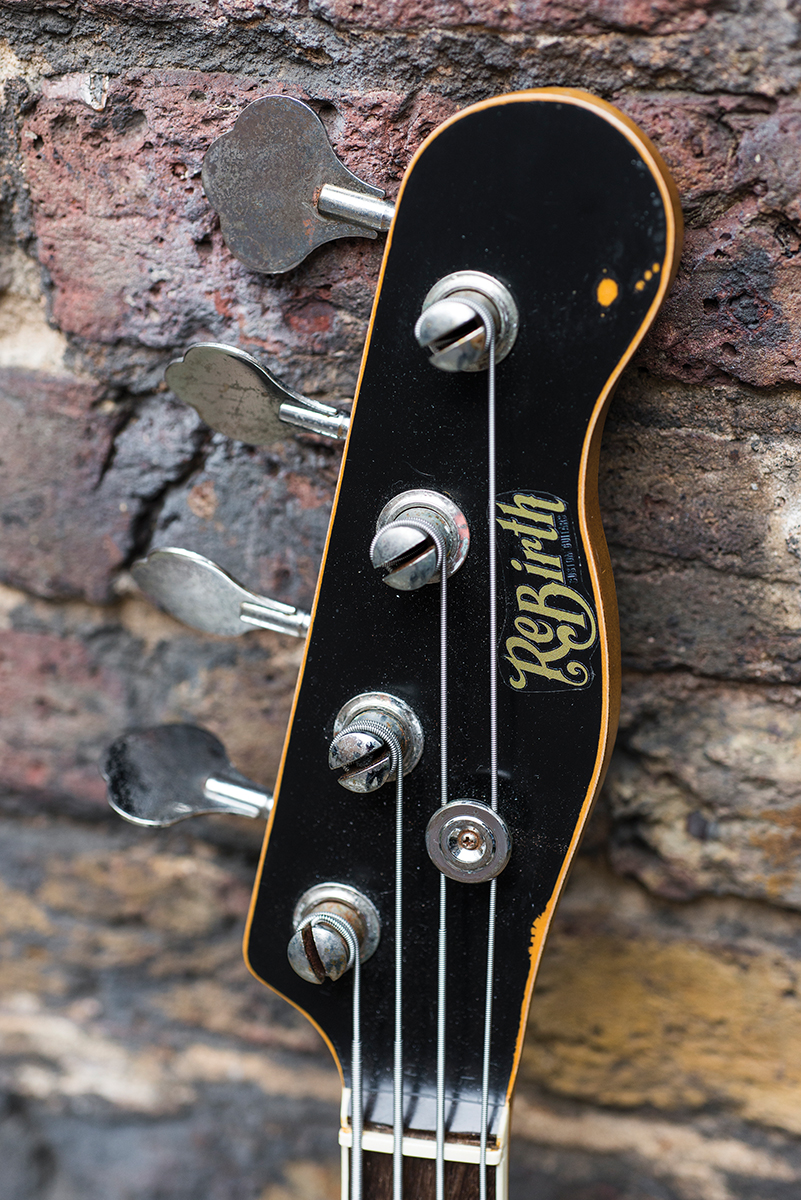
“So at first I was just customising cheaper Fenders, Squiers and Epiphones I found on eBay, but then I was like, ‘Hmm, these are actually quite expensive… maybe I should start to build myself!’ So that’s how it extended from customising to actually building. Now I’ve got my man cave – I used to do it in the kitchen but my girlfriend kicked me out! So I asked my neighbour, who’s got this really nice brick shed that they’re not using, if I could go in there, so now I do all my work in there!

“I’ve got loads of respect for Fender and Gibson, but sometimes I just wish they’d do something that’s a bit different… so that’s what I do. And it’s quite fun as well!”
Feeder’s combined hits/mini-album collection, The Best of Feeder/Arrow is out now on BMG.
